Lately I’ve been feeling the urge to return to Japanese cinema. Specifically the films of Yasujiro Ozu and Akira Kurosawa. With both infamous directors having styles on the complete opposite ends of the spectrum, I figured I’d find some commonality between two films, one from each, and go from there. I finally landed on “The Flavor of Green Tea Over Rice” by Ozu and “Drunken Angel” from Kurosawa. Both films are black and white postwar films that take place in Tokyo, and that’s enough for me. I’m especially looking forward to “Drunken Angel” as it was Toshiro Mifune’s first pairing with Akira Kurosawa in cinema. Though I have heard excellent things about Ozu’s film as well! Let’s dive in!
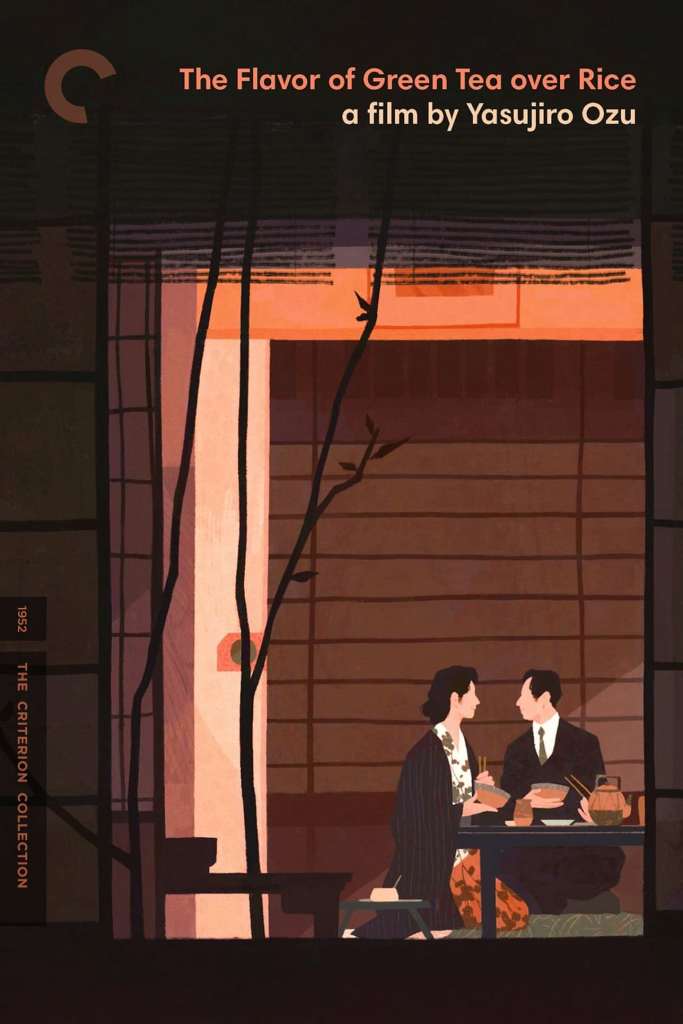
Written by Kôgo Noda and Yasujirô Ozu, and directed by Ozu, “The Flavor of Green Tea Over Rice” is similar to almost every other film that Ozu has directed in his time, which usually involves familial drama. Ozu’s works mostly focus on a particular aspect of interpersonal social situations within the family dynamic that are played out to charming, often melancholic, and sometimes horrifically depressing, effect. “The Flavor of Green Tea Over Rice” falls into the charming but a bit melancholy category. It’s a fine film, particularly due to Ozu’s directorial touch, but it’s not quite as fufilling as his late ‘Master Period‘ that I dove into earlier back in quarantine (https://spacecortezwrites.com/2020/06/18/quarantine-2020-catch-up-rapid-fire-reviews-5-yasujiro-ozus-master-period/). As in every Ozu film, there is no typical lead character at the forefront, it’s an ensemble that focuses mostly on the Satake family, but with flourishes of family friends and close associates. The brunt of the initial plot progression rests on the shoulders of the young niece of Taeko (Michiyo Kogure) and Mokichi (Shin Saburi) Satake, Setsuko (Keiko Tsushima) who fiercely opposes her parents’ demand that she participate in the traditional arranged wedding. However, once Setsuko decides to hide out at her aunt and uncles to avoid this outcome, both Taeko and Mokichi look inward and take stock of their own faltering marriage that was also arranged.
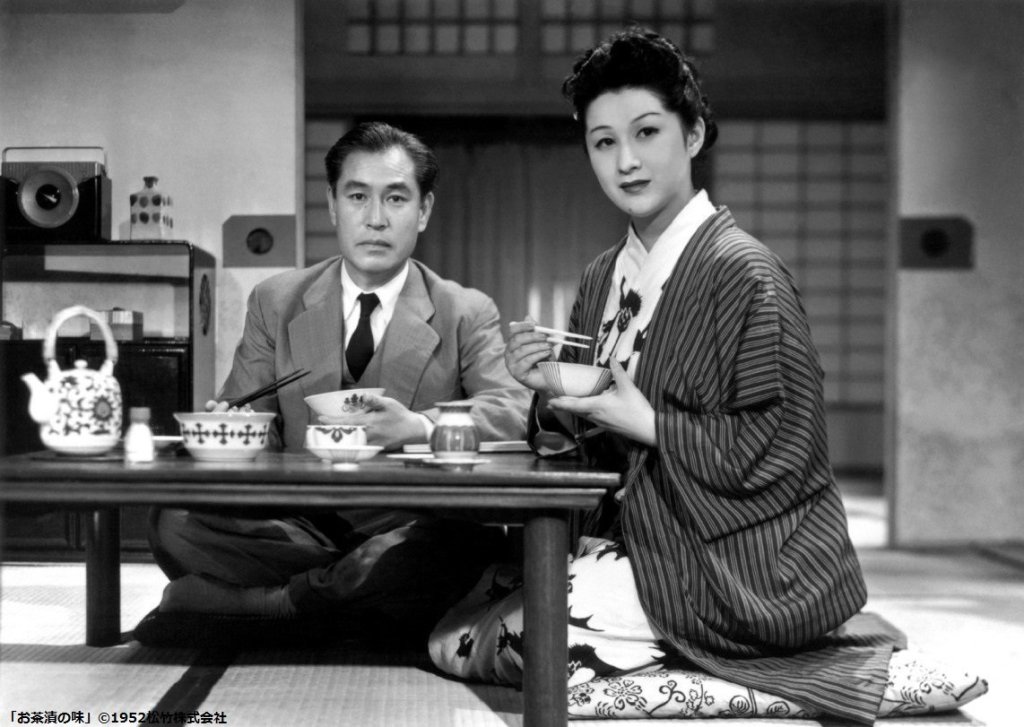
Throughout the film both Taeko and Mokichi are presented one way, then their layers of personality and true selves slowly emerge as the story goes on. Though, admittedly Taeko’s evolution is more abrupt and not as easy to digest- at least for me. It may take a rewatch to better unerstand her character’s evolution across the movie but for the majority of her time onscreen she behaves as a selfish socialite with no empathy. It isn’t until late in the film when Mokichi tries to explain the differences between them and why that may be. He’s willing to behave and act the way she wants him to, but he falls into old habits without thinking about it, like taking the economy class on the train because he prefers it to first class, or smoking a cheap brand of cigarettes not because they’re cheap but because he just likes them that way. Or pouring his stew over his rice, which she detests as it’s not proper. She was raised in an upper class lifestyle in Tokyo, and he was raised in a working class family in the country. After Mokichi is assigned to an abrupt relocation to Montevideo in Uruguay for his company, Taeko finally protests (not knowing of his immediate reassignment) her “Bonehead” husband and takes off to a friend’s place out of town for a few days. She hears of his reassignment, but decides to stay and not see him off to Uruguay. She returns after he leaves and has time to let his assessment of their marriage absorb for a couple hours until he walks back through the door unexpectedly, the plane had experienced some engine troubles. Thus right when you expect a reckoning between the two, a hashing out of both of their ideologies and actions- they instead have a tender late night snack in their kitchen together as they try to find ingredients and utensils without waking up their maid. While they eat, and later as Taeko retells the exchange to her friends and family after Mokichi leaves the next morning, Taeko has an epiphany about her husband’s nature through simplicity. They agree that marriage doesn’t need to be all about social expectations or a bourgeois way of life, but rather through authenticity and humility- something as simple as green tea over rice.
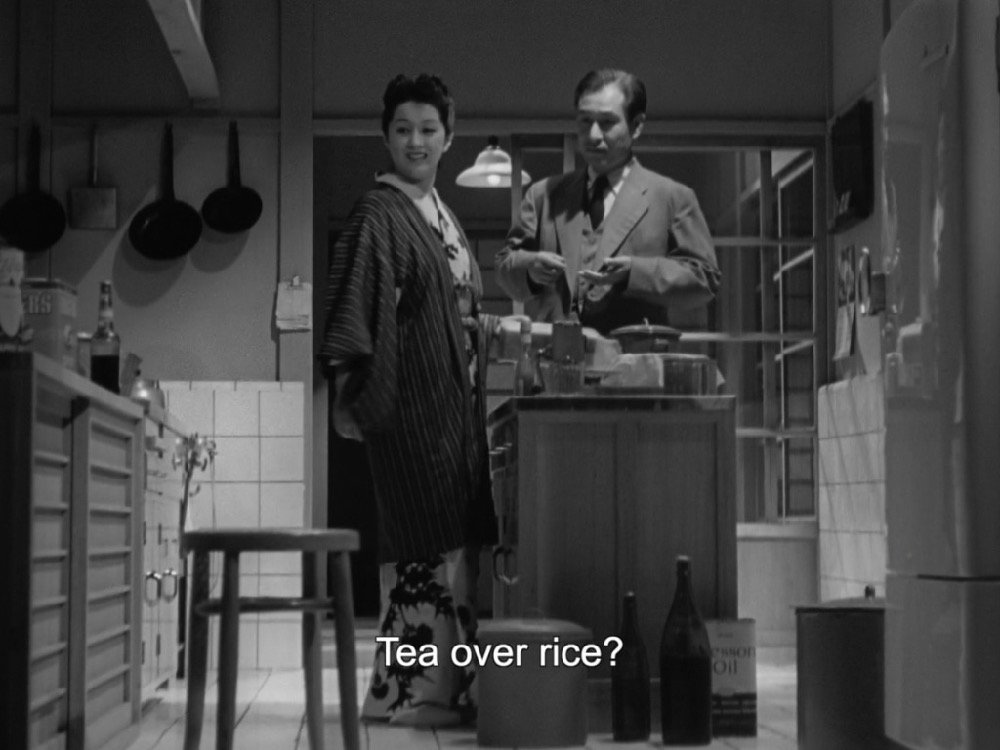
Ozu was never one to have an explosive argument where one might expect such an outburst, in fact this may be his most restrained film (of the ones I have seen thus far). Even the smallest of emotions or dialogue gets an equal amount of respect and devotion. The script and direction do not judge their characters even when they’re acting out like children. I shouldn’t have expected a blowout between Taeko and Mokichi, but everything that had happened in the film up until then would suggest such a scene. Instead Ozu has Taeko re-evalute her husband’s self-compsure and reliability as strengths, not weaknesses as she thought before. As for the filmmaking itself, I was quite surprised to see Ozu move the camera, at all! This film has the most camera movement that I’ve seen from Ozu, granted they were just a lot of push inserts and pull outs, but still! This film also may have had the greatest variety of scenes set outside of the home, Ozu’s main setting in each of his films. Characters go to bicycle races, a Pachinko parlor (which results in a delightful but short appearance of the great Ozu regular Chishû Ryû as a wartime friend of Shin Saburi’s Mokichi!), a Kabuki theater, and several ramen shops. There’s also quite the influence of American consumerism since this is a post-war film set in Tokyo, though Ozu’s “Good Morning” (https://spacecortezwrites.com/2019/05/31/old-school-review-good-morning-1959/) had this hashed out in a more prominent way. I think this is a fine film from Ozu, it may not reach the heights of some of his great films, but I’d still recommend it. To be fair though, I would not recommend this as your first Ozu movie, I’d suggest either “Tokyo Story”, “Good Morning”, or “Floating Weeds” (1959) instead.
Final Score: 2 bowls of Ramen
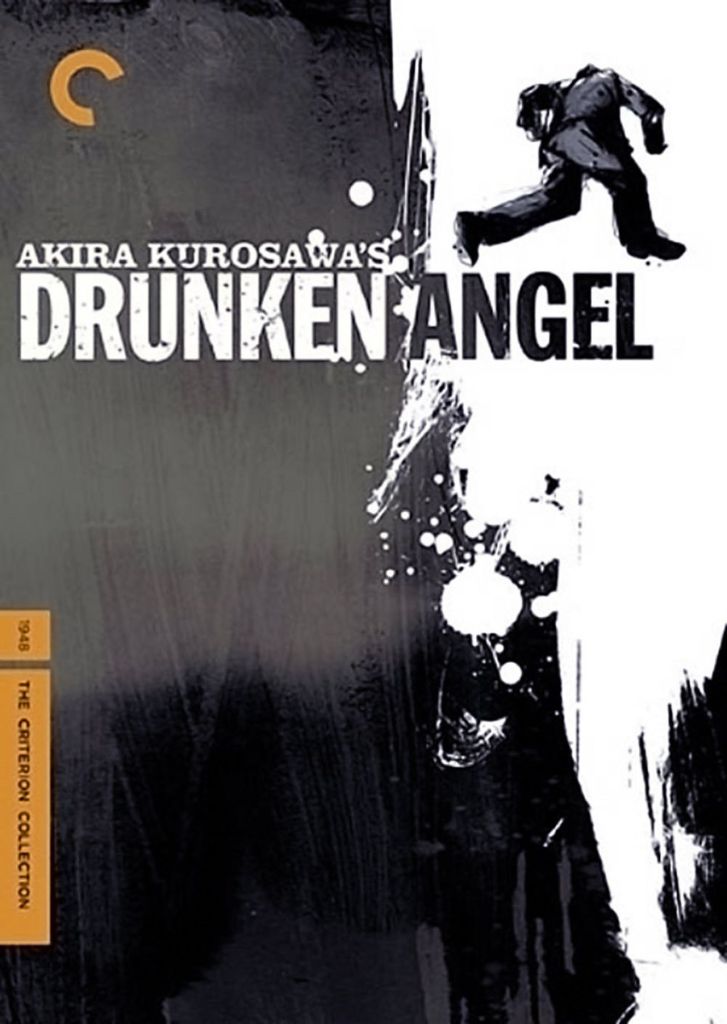
Written by Keinosuke Uekusa and Akira Kurosawa and directed by Kurosawa, “Drunken Angel” is the fiery introduction of a pairing of actors that Kurosawa would employ many more times throughout his filmmaking career with Takashi Shimura and Toshiro Mifune. While this was the first role that Mifune would take on with the bravura director, many staples of his future characters appear more forthright in Takashi Shimura’s Doctor Sanada. Sanada is a loud, brash, and temperamental Physician who attacks his patients’ problems as if he’s personally going to war with each illness, but at his core he has an unyielding set of principles and of doing the right thing despite the challenges. He even has a similar lack of empathy for anyone that has a subservient attitude or a sacrificial personality, something that would come to be a cornerstone of legendary Mifune characters like the legendary ronin, Yojimbo (https://spacecortezwrites.com/2018/02/02/old-school-review-akira-kurosawas-yojimbo-1961/). The good doctor has no patience for people that won’t take initiative to solve their problems, and this surprised me as I’m mostly familiar with Shimura’s later work with Kurosawa like “Ikiru” (https://spacecortezwrites.com/2017/11/03/old-school-review-ikiru/) or the Woodcutter in “Rashomon” (https://spacecortezwrites.com/2019/01/10/old-school-review-rashomon-1950/). Toshiro Mifune’s Matsunaga is a local gangster who’s diagnosed early on in the film with TB, or Tuberculosis. The first half of the film is more devoted to Doctor Sanada as he tries to help the volatile and incendiary young man- but Matsunaga’s prone to taking offense at the Doctor’s incredibly blunt methodology of handling patient interactions. We get a better understanding of Matsunaga as the film progresses into the second half, but I was incredibly entertained by any scene with both characters as most sequences end with altercations involving lapel hoisting, shouting, and throwing glass bottles at each other.
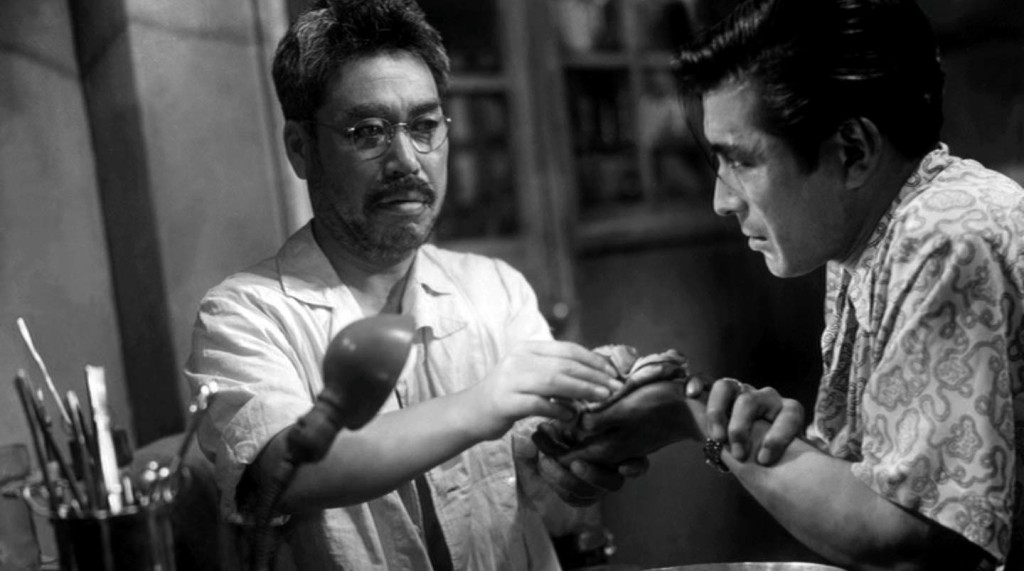
Both Sanada and Matsunaga have mentors and friends that are either directly spoken of or keenly referenced in the first act that inform the audience as to how these men were shaped in their formative years. While Matsunaga’s only just broken out of that time in his life, Sanada’s impressionable period has long since passed. For Sanada that man is Takahama (Eitarô Shindô), they both went to the same school for medicine and while Takahama is far more profitable by this point in his life, he highly regards his old miscreant friend as one of the best doctors around. Unfortunately for Matsunaga, his mentor and friend is Okada (Reizaburô Yamamoto), former gang boss of the muddy backwaters and alleyways of the district that Matsunaga and Sanada live and work in. After Okada returns from prison, he upends the power structure that had Matsunaga at the top temporarily. Okada quickly makes moves to place himself back atop the criminal pyramid in the district. He can smell Matsunaga’s weakness as his health deteriorates throughout the film, for while the young and gruff gangster seems to want to take Doctor Sanada’s orders seriously by the time he realizes just how bad he has it- but his fear of losing face among his peers and especially with Okada drives him to failure. Okada isn’t just a menace for Matsunaga though as Sanada’s assistant at his practice, Nanae (Michiyo Kogure* Who played Taeko in ‘Green Tea Over Rice’!), is a former flame of the elder gangster and he wants her back. While Sanada himself may be an alcoholic, he doesn’t let that sway his principles when Okada comes knocking after some goons see Nanae at the small clinic when they brought Matsunaga to the Doctor after collapsing. The gruff doctor defends Nanae and the ghost-like Matsunaga, who attempts to save face at any cost.
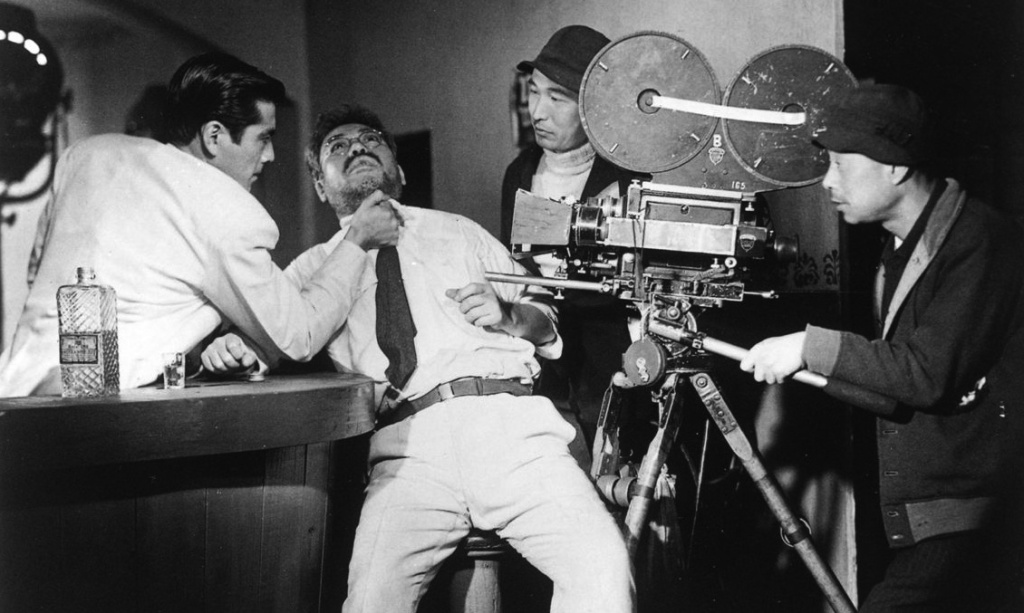
I won’t spoil the film’s infamous ending, but it’s a good one. It involves a desperate and animalistic knife fight that I won’t likely forget soon. Expectations should be kept in check though, it’s not like this is a knife fight that could rival the one in “John Wick 3” (https://spacecortezwrites.com/2019/05/21/review-john-wick-chapter-3-parabellum/), but narratively it works very well. From the filmmaking side of things, Kurosawa uses the natural elements to cleverly layer the film with mood and atmosphere that directly relate to the characters and the story at hand. The Doctor’s clinic for example is nearly surrounded by a bubbling black bog, a leftover from the war that hasn’t quite been attended to yet. There’s some whipping wind and rainfall when it’s needed most, just excellent creative decisions all around. There’s also some fun abstract visuals in the form of Matsunaga’s fever nightmare sequence where he cracks open a casket on the beach which reveals a very much alive and horrific version of his former self that leaps out of the shattered box and chases him down the beach as waves violently crash around them. “Drunken Angel” is an excellent crime noir that embellishes the genre with some damn fine artistry amongst all the fistfights and broken glass.
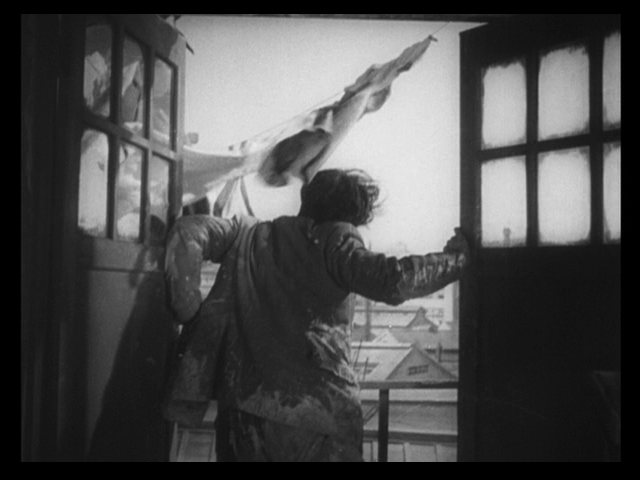
I highly recommend giving this one a watch. More broadly, I strongly suggest seeking out films from both of these legendary Japanese directors. This pairing of films is the perfect distillation between the two extremely divergent styles of directing and storytelling as a whole. Yasujiro Ozu’s films are about the quiet and everyday dramas that unfold between family members and friends in houses, bars, and offices whereas Akira Kurosawa’s films are about more Macro sensibilities that occasionally take place in a modern setting, but more often than not are set in Japan’s past and reflect broader sentimentalities, usually with larger casts and set-pieces. Though Kurosawa does have more lead characters with individualistic characteristics than Ozu overall. Kurosawa’s narratives are almost always about the broader nature of human beings as a whole, while Ozu’s universality comes from his focus on the everyday drama of the family, but both can be enjoyed by everyone and anyone. Please give these filmmakers a chance, they are some of the medium’s absolute best.
Final Score: 1 Guitar


